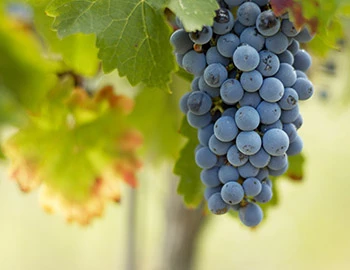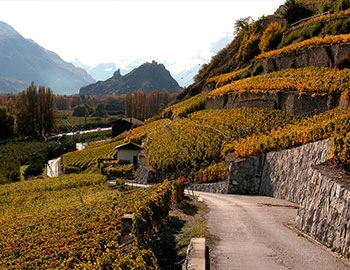
Il Canto della Terra 2021
DOC Ticino, Cantina Monti, 750 ml

| Grape variety: | Merlot |
| Producer: | Cantina Monti |
| Origin: | Switzerland / Tessin / Sottoceneri |
| Other vintages: |
Description
This wine is made from Merlot grapes that come exclusively from selected vines that have been growing in the Ronchi di Cademario for at least 30 years. On average, almost three vines are needed for a 75 cl bottle. The sun-drenched plots on a slope with a 70% gradient face south-southeast and can only be cultivated manually. A drop full of richness, density and character and the best example of what can be created with a lot of heart and soul, manual work and the optimal terroir.
Attributes
| Origin: | Switzerland / Tessin / Sottoceneri |
| Grape variety: | Merlot |
| Ripening potential: | 5 to 10 years |
| Drinking temperature: | 16 to 18 °C |
| Food Pairing: | Bistecca fiorentina, T-Bone steak, Roast saddle of venison, Saddle of lamb fillet with herb jus, Châteaubriand, Filet Wellington, Cheese board, Cold fish dish, dried meat |
| Vinification: | long must fermentation, fermentation in steel tank, fining |
| Harvest: | hand-picking |
| Maturation: | in used barriques, in large wooden barrel/foudre |
| Bottling: | filtration |
| Maturation duration: | 12 months |
| Volume: | 14.5 % |
| Note: | Contains sulphites |
Cantina Monti
Located at 550 meters above sea level, with extreme slopes, the Cantina Monti covers 4.7 hectares. The sloping soil does not allow mechanization in the vines, which includes nine different grape varieties. Every season, the Monti family immediately focuses on the production of superior quality wines, a quality also given by the very low yield in the vineyard.
For Cantina Monti, discipline and respect for the harvest are the keys to the success of the vintage. This means protecting nature and embracing the methods of Integrated Production in order to minimize interventions in the vineyard. The time of harvesting is essential, and must take place at the right time. For this reason, at the Cantina Monti several harvests are carried out, depending on the vine in question. Even in the cellar there are rules: the less the product is scrambled, the more the integrity of the wine itself is guaranteed insuring a taste created by nature.

Merlot
Everybody’s darling
Merlot is the most charming member of the Bordeaux family. It shines with rich colour, fragrant fullness, velvety tannins and sweet, plummy fruit. It even makes itself easy for the vintner, as it matures without issue in cool years as well. This is in contrast to the stricter Cabernet Sauvignon, which it complements as a blending partner. Its good qualities have made the Merlot famous worldwide. At over 100,000 hectares, it is the most-planted grape in France. It also covers large areas in California, Italy, Australia and recently in Eastern Europe. The only catch is that pure Merlot varieties rarely turn out well. Its charm is often associated with a lack of substance. Only the best specimens improve with maturity. They then develop complex notes of leather and truffles. This succeeds in the top wines from the Bordeaux appellation of Pomerol and those from Ticino, among others.

Tessin
Ticino: the Merlot Mecca of Switzerland
Ticino winegrowing is thought to date from Roman times, as early as 2000 years ago. But the foundation for today’s viticulture was laid just over 100 years ago, in 1907. It was then that the first Merlot vines were planted at Castelrotto in Malcantone. Since then, the variety has emerged triumphant here. Top selections matured in barriques more than measure up to those from Bordeaux’s Saint-Émilion or Pomerol regions.

Switzerland
Switzerland – A small country with enormous diversity
Switzerland is famous for its banks, watches, and cheese, but not necessarily for its wine. The Swiss didn't invent wine, but they have been extremely open and curious to it. Wine culture arrived in what is now modern Switzerland via several routes: from Marseilles to Lake Geneva and the Lower Valais region; from the Aosta Valley through the Great St. Bernard Pass to the rest of Valais; from the Rhone through Burgundy, across the Jura Mountains to Lake Constance; and from Lombardy to Ticino, and then on to Grisons.


